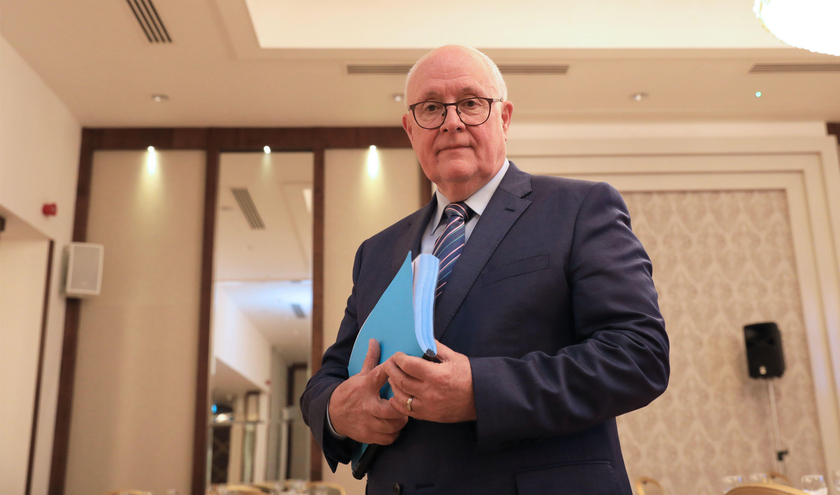The launch of the New Towns Taskforce report in Liverpool last month was an anomaly. Government-commissioned reports are not usually launched as political events, and large-scale house-building projects are not usually welcomed.
While some of the 12 individual sites highlighted by the report – and some of those that missed out – may beg to differ, the report has been phenomenally well received. And while the 12 sites identified for development will not, on their own, resolve the housing crisis overnight, it goes some way to shifting the dial.
Speaking to The MJ in the aftermath of the launch, chair of the taskforce Sir Michael Lyons was quick to recognise the scale of the challenges facing local government – not unlike the early part of his local government career in the 1970s when the country faced the challenge of grand-scale deindustrialisation, or in the post-war period.
Now, he said: ‘This is a very difficult time to be proposing ambitious public expenditure programmes and a single-minded focus for government.
‘There are so many things going on, but in 1946 you had the same job of the revitalisation and rebuilding of a country that's been through terrible times. You had the same massive range of issues the Government had to deal with.'
And then there is the backdrop of local government reorganisation (LGR). While different people within government are pursuing LGR and housing, he suggested there was a failure to fully understand ‘the contradiction' of restructuring councils while encouraging housebuilding.
But, like the excitement of his early career tackling the big issues facing the country, he is positive about the dual challenge of housebuilding and economic growth. But he warned: ‘You can't do it all in a couple of years.
‘I understand the ambition for 1.5m homes in five years, spades in the ground by the end of this Parliament. But actually, the real legacy work will be in 20-30 years' time.'
It is about building the foundations – metaphorically and physically – now to provide young people with homes and jobs in the future. Even if all 12 sites went ahead, it would only provide 300,000 and not in time to hit the 1.5m target. It is not enough.
When he completed his previous housing review for Labour when they were in opposition, Sir Michael was clear there was no one solution to the housing crisis.
Speaking to The MJ, he said: ‘You've got to get the whole orchestra playing… we've got a huge deficit to catch up on'.
‘You want absolutely as many homes being built for sale as possible, with attention to how those homes can be made affordable.
‘Social housing has a very important part to play.'
Despite the lack of money in the public purse, there is cash available. ‘The gap between housing demand and housing supply in this country is so immense that you would expect the market to be strongly focused on it and the opportunities it brings,' Sir Michael said.
And so do councils. He added: ‘I think there are lots of local authorities that, even in the really demanding circumstances of the moment, are doing a good job on maintaining house building programmes.'
Sir Michael admitted he was not a ‘new town zealot' and wondered if he was the ‘right person for the job'. But in truth, the New Towns Taskforce is a misnomer – it is not all about new towns.
The remit was wider, and it was a tough ask. Sir Michael explained: ‘The remit was very precise about what it wanted and quite demanding to be achieved in a year.'
It put economic growth first, and housing second. And in addition to policy recommendations, it needed practical actions. The taskforce chair stated: ‘It was very clear that we had to come up with, not only named locations, but named locations where work could be done in this parliament.
‘It is really about laying the foundations for the revival of large-scale developments.'
Some of those are new towns, some urban extensions, and some urban regeneration projects.
Despite the lack of money in the public purse, there is cash available. ‘The gap between housing demand and housing supply in this country is so immense that you would expect the market to be strongly focused on it and the opportunities it brings,' Sir Michael said.
And while Government tends to focus on builders, he said: ‘Actually, it's a dialogue between government and investors and landowners, including public landowners.' And it is about the vision.
The issues raised in the taskforce are not going away anytime soon. Sir Michael said: ‘Whoever is elected as the next Government or the one after that, will still face a housing crisis in this country.'
He cited the impact of housing on economic growth, health, education attainment and on the social contract with young people.
‘I think for all parties, and particularly parties who want to focus on those parts of the community who feel that they have been ignored and overlooked, then housing is absolutely a key.'
There is not the scale of public finance available to the 12 projects that they may have liked ‘in an ideal world', but they have the support of central government. If they have ‘vigorous local authorities wanting to bring them about' he is confident there will be some success, despite – or perhaps even because of – the challenges faced.



